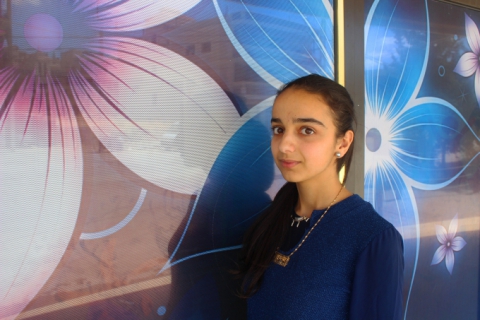The power of a young voice

There are 14 kilometres separating the two villages. One, Majdal Anjar, sits right next to the Syrian border. The other, Qab Elias, lies at the foot of sloping mountains on the edge of the western plateau of Lebanon’s Bekaa Valley.
Though geographically split, social challenges and predicaments unite the two towns.
Children and youth in the two areas make up 60 percent of a combined population of 126,000 people. Up to 40,000 of those are Syrian refugees. A soaring population has meant that living conditions have become harsher. Adnan and Rana, two residents of these towns, felt they had a role to play in this struggle.
The Syrian youth, 20, and the Lebanese girl, 16, decided that Save the Children’s Participatory Action Project was a promising initiative to be part of. The youth-led programme, delivered by the Food Security and Livelihoods team in Bekaa, aimed to identify challenges facing children and youths on a daily basis. The duo joined their groups for training, conducted by Issam Fares Institute at the American University of Beirut, on interviewing and research techniques before going out on the streets, trying to understand problems facing hosts and refugees alike.

‘’We went out to the field, looking for Lebanese residents and Syrian refugees,’’ said Adnan, whose mission was to inspect renting problems.
‘’We wanted to put the finger on common issues.. We asked if families were staying in rented houses. Who pays for the rent and how many people in the household work. How many members there are in the family. The size of the house.
Having identified four or five main problems that existed in the majority of households we visited, our next step is to come up with a project that solves these problems.’’
In Majdal Anjar, Rana and her friends wanted to know what was needed to alleviate the misery of thousands of refugees stranded in makeshift tents with their children. They found out that people were living within the minimum shelter and protection standards.

Rana* said, ‘’Some families had to go outside their house to have a shower. Others had to split a room using curtains, so they could have two spaces; for living and sleeping.
''We also saw children who worked to secure bread for their families. We felt we had to get their message across. Let voices be heard. The voice of a 12-year-old boy working in construction because he had no other option.’’
Save the Children’s project, executed in the two Bekaa towns in addition to a third village in the North, aims to give a voice to youth and encourage them to express their worries and ambitions. It hopes to contribute to the introduction of much-needed change in their social environment.
Having identified these problems, the youth now want to see tangible change. They are hopeful that their recommendations will translate into actions to improve life for all communities.
The experience has left a great personal impact. The two youngsters speak of being more open and confident. They understand the suffering of people.
‘’I learned that if one wants to help one can,’’ said Adnan.
‘’Save the Children has succeeded in bringing together this group of youth, who work together to create a new atmosphere. These young people, like myself, acquire essential life skills here. We feel we are doing something great- putting a positive spin on the misery of too many people.’’
If there is one reward that Adnan and Rana can think of, it is that change to the better.
*Names have been changed for protection purposes.
 Lebanon
Lebanon